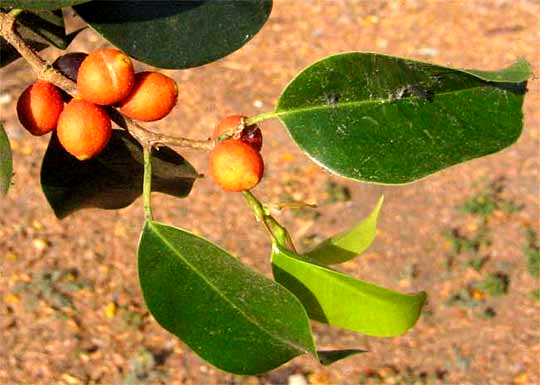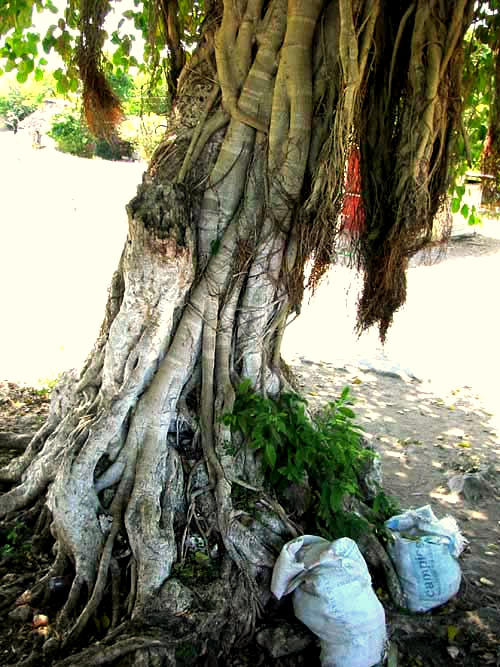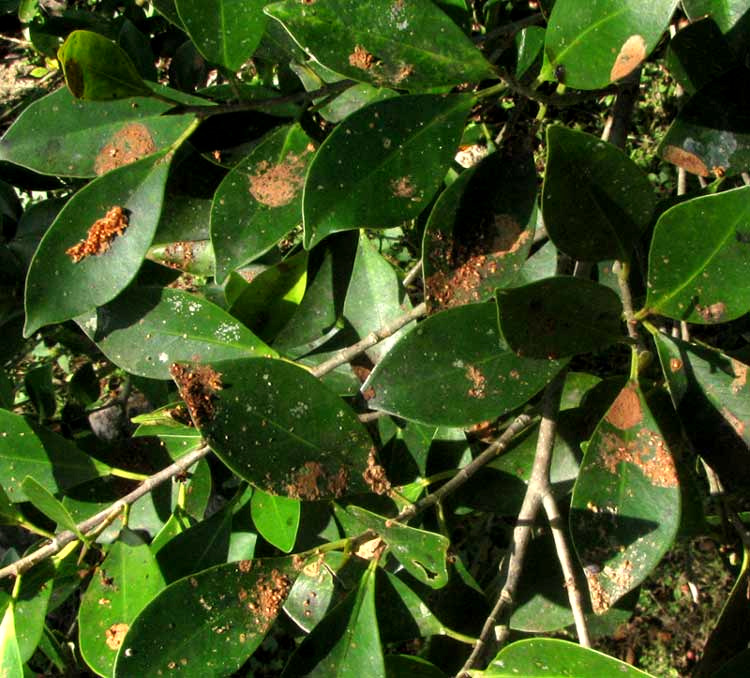Excerpts from Jim Conrad's
Naturalist Newsletter
from the March 10, 2008 Newsletter written in the community of 28 de Junio and issued from a ciber 8 kms to the west in Pujiltic, Chiapas, MÉXICO, at about 800 meters in elevation, ± LAT 16° 18'N, LONG -92° 28'W.
CACOPHONOUS FIG-TREE
Back in the Yucatan I introduced you to strangler figs. We saw how they start out as little bushes growing epiphytically on a host-tree's limbs. They send viny roots earthward, the roots grow and merge with one another, and eventually the little bush becomes a tree that out-competes and overtops, or strangles, the host tree, eventually replacing it. The resulting fig tree looks like any normal tree developing the usual way (picture below).
Strangler figs are common here and right now some are producing prodigious amounts of small, spherical figs. Remember that our American figs produce much smaller fruits than the does the Common Fig of commerce, which is a native of the Mediterranean Region, plus they produce different-shaped leaves. You can see a fig-bearing, leafy branch from one of our big strangler figs, the figs smaller than a fingernail, below:

During most of the fig-fruit's development it's hard and green but now many of them are orange and semi-soft. When they're completely mature they turn dark brown and really soft. The brown ones don't last long, though, because birds eat them. Unfortunately, to human tastes they're so bland and pithy that they're not worth fooling with them.
Still, those big stranglers are bird-paradises. Not only do they offer an all-day banquet to all comers but also, in stark contrast to most other trees here, the figs' leaves are as green as at the peak of the rainy season, and they're produced so close together that they form dense shadows inside the trees, which birds crave during the midday heat and glare.
Many bird-types visit the stranglers but at mid-day the most common species in the big one next to the church are Great-tailed Grackles and Social Flycatchers. Both of these species are famous for their ceaseless, often shrill calling, so at mid-day when most of the world here is withdrawing into heat- induced torpor the big strangler is like a circus on free-to-kids day. Beneath the tree there's of a continual shower of fig fragments and bird doo.
Remember that fig fruits, including the big ones bought at the market, are very unusual anatomically. You know how a composite flower such as a sunflower is actually composed of many tiny flowers crammed together on a flattish disk. Fig fruits start out in a similar way, except that many tiny pistils are stacked next to one another on the inner surface of a spherical object. Think of the edges of a sunflower's flattish disk curving upward and then coming together, leaving the sunflower's disk flowers inside the structure all pointing toward the sphere's center.
Below, you can see a split-open fig from our church tree, with each tiny, grainy thing being an ovary with its pointy style directed toward the fig's open center:

You might wonder how the pistils preceding the maturation of these strange fruits, which technically are called syconiums, ever get pollinated. The syconium has a small opening opposite its pedicel attachment, and a certain species of tiny wasp enters the fruit where it walks around inside it distributing pollen from other syconiums and gathering new pollen.
from the September 1, 2008 Newsletter written in Sabacché and issued from a ciber in nearby Tekit, western Yucatán, MÉXICO
STRANGLER FIG LATEX FOR TOOTHACHE
Last Monday after issuing the Newsletter in Tekit I took a bus to the tiny village of Ochil, then had to wait an hour for the next bus back to Sabacché. A couple of men from Sabacché happened to be making the same trip so they invited me to go with them to Ochil's little park where sometimes beneath a big shadetree a breeze managed to stir. Apparently this layover was a weekly event for them, for as soon as we reached the tree one of the men let out a hoot and a whistle, which were noted by a clot of men lounging across the street. In no time they were visiting us, bringing a big jug of firewater, which they proceeded to pass among themselves.
The big shadetree turned out to be one of several strangler fig species in the area. The various stems of our strangler were still in the stage of fusing together, which you can see below:

In that picture, the dark, hairy-looking stuff is masses of branching, fibrous roots dangling in mid air. Earlier there were arm-thick stems but someone macheted them, probably just for the fun of it, and now roots sprout from the exposed cambium. If the mass of fusing-together trunks in the picture is allowed to grow for a few more decades, someday there'll be a regular trunk with bark like elephant skin, and it'll be hard to believe the trunk ever looked like this.
Not wanting me to be left out of the group, one of the guys walked over, snapped off a strangler leaf, pointed to the milky latex emerging from the leaf's petiole and told me the juice was used for toothache.
"You daub the juice on your tooth and it helps a little," he said. "Of course before long the tooth starts hurting again, but then you daub some more juice on it."
You can see the strangler's milky latex oozing onto my finger from where the leaf was snapped off the stem below:

While you're looking at that picture you might notice the "stipular ring" encircling the stem. Stipules are tiny, much-modified leaves that usually serve to protect flowers and stems as they emerge from buds. Once the flowers or stems have emerged, typically the stipules fall off, leaving modest scars. Most woody plants have no stipules or else only small ones, which leave tiny, usually overlooked "stipular scars" right above where the leaf's petiole joins the stem. But figs are one kind of tree with relatively large stipules, which leave scars completely encircling the stems. If in your house you have a Ficus elastica, which is a kind of fig, you might see if you can find its stipular rings.
Latex freshly issuing from a fig's wound is watery but once it airs awhile it thickens, and eventually becomes surprisingly sticky. It'd make decent glue for keeping papers together. I'm guessing that fig latex daubed onto a tooth cavity momentarily plugs it, keeping air from reaching the nerves.
from the January 8, 2012 Newsletter issued from Hacienda Chichen Resort beside Chichén Itzá Ruins, central Yucatán, MÉXICO
A THEORY OF FIG-SEED DISSEMINATION
Long ago I read somewhere that strangler fig seeds get to the host-tree branches via birds who've been eating the fruits. The fruits are juicy with sticky latex, so seeds stick to the birds' bills. When the birds fly to another tree they clean their bills on the branches they're perched on, sowing the seeds.
Currently our Chinese Banyan, which is an introduced strangler fig, is producing prodigious numbers of garbanzo-bean-size figs, which attract large numbers of birds who gorge on them. Eating so much fruit, the birds' poop becomes watery. The birds drop their poop frequently, splattering everything below them. Such seed-filled, dried-out poop on leaves is shown

It may be that birds cleaning their beaks on candidate host trees sow the seeds there, but I'm thinking that so many seeds get sown by birds with the runs that beak-sown seeds must be a minority.